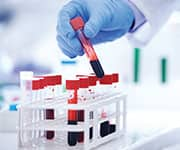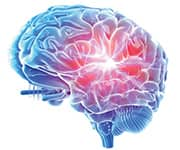Life Extension Magazine®
Doctors often overlook an amino acid in the blood called homocysteine that can increase risk of:
- Cerebral vascular disorders,
- Dementia,
- Arterial calcification, and
- Hearing loss.
There are many ways that elevated homocysteine can harm health.
Since 1981, Life Extension has advised annual monitoring of homocysteine status with a simple blood test.
A young, healthy body can reduce homocysteine by converting it to non-toxic compounds.
Older individuals often need B vitamins to reduce homocysteine to youthful ranges.
What is Homocysteine?
Homocysteine is an amino acid produced in the body during the metabolism of a common dietary amino acid called methionine.1,2
Vitamins B6, B12, riboflavin (vitamin B2), and folate help break down homocysteine into other, beneficial amino acids.2-5
Deficiencies in these vitamins may lead to elevated homocysteine levels, a condition known as hyperhomocysteinemia.6
Elevated homocysteine may also arise from genetic defects or mutations in enzymes involved in the metabolism of methionine.1,7
The Risks of High Homocysteine Levels
Elevated homocysteine has been associated with the development of atherosclerosis, stroke, cognitive disorders,2 and hearing loss.8
The normal homocysteine blood range for commercial laboratories is between 5 and 15 micromoles per liter (μmol/L).
Life Extension believes that homocysteine levels below 12 µmol/L are good and that the ideal blood levels should be below 8 µmol/L, much lower than the currently accepted < 15 µmol/L.
Homocysteine Harms Arterial Health
The potential role of elevated homocysteine as a risk factor for vascular calcification progression was suggested in a study published in 2020 in the Journal of the American Heart Association.9
Calcification of arteries and heart valves is considered irreversible, though Life Extension is researching methods to reverse calcified tissues.
Elevated homocysteine is an independent risk factor for atherosclerosis.10
In a study in Africa, patients who had suffered a stroke were found to have, on average, significantly higher homocysteine levels than healthy subjects. They also had lower average vitamin B12 levels.11
A 2020 review of human studies involving more than 11,000 participants determined that high homocysteine levels were associated with increased risk of stroke. For every 1 μmol/L increase in homocysteine, the relative risk for stroke increased by 6%.12
Researchers believe homocysteine may cause arterial damage and reduce the flexibility of blood vessels. It may also contribute to oxidative stress and inflammation in blood vessels and reduced production of nitric oxide, a key compound for endothelial health.1
Homocysteine may also increase dangerous clotting in the blood,1 reduce the synthesis of HDL (“good”) cholesterol,13 and promote the oxidation of LDL (“bad”) cholesterol, which contributes to atherosclerosis.10
Brain Aging
Evidence shows that elevated homocysteine plays a role in brain aging.
MRI scans of 36 healthy volunteers between ages 59 and 85 revealed that those with higher homocysteine levels had greater loss of white matter. This brain tissue is composed of fibers that conduct nerve signals.14,15
Some evidence suggests that elevated homocysteine may increase the risk of Alzheimer’s disease.16
For example, individuals with elevated homocysteine levels are more likely to have markers of Alzheimer’s disease progression in brain tissue, including neurofibrillary tangles, dysfunctional protein accumulation, and brain shrinkage.17
One meta-analysis found that every 5 µmol/L increase in homocysteine levels is associated with a 15% increase in Alzheimer’s disease risk.18
In patients with Parkinson’s disease, elevated homocysteine has been associated with worse cognitive function.19
Even modest elevation of homocysteine within the normal range (>11 µmol/L) has been associated with a substantial increase in risk of dementia in the elderly.17
Hearing Loss
A range of studies over the past 20 years have shown that high homocysteine levels are associated with hearing loss.
One 2019 study found that among 52 patients experiencing sudden hearing loss, 63% had higher than normal homocysteine levels.20
Another study the same year noted that participants with sudden deafness had higher homocysteine levels and lower folate levels than those with normal hearing.21
Australian researchers reported that of 2,565 study participants, those with high homocysteine levels had a 64% increased likelihood of hearing loss. Low folate levels also increased the odds of mild hearing loss.22
What you need to know
Keeping Homocysteine at Safe Levels
- Homocysteine is a non-essential amino acid produced in the body.
- High homocysteine levels can be toxic, increasing risk for cerebrovascular disease, brain disorders, and hearing loss.
- A simple blood test can determine homocysteine status. Levels above 15 µmol/L are considered high, and Life Extension recommends maintaining levels below 12 µmol/L, with levels less than 8 µmol/L being optimal.
- The body relies on B vitamins to lower homocysteine levels. Oral intake of vitamin B6, vitamin B12, folate, and riboflavin can safely reduce homocysteine concentrations in the body.
Strategies to Lower Homocysteine
Several B vitamins can help safely reduce homocysteine levels.23,24
Vitamin B6 aids the body in metabolizing homocysteine because a B6-dependent enzyme converts homocysteine into cysteine, a beneficial amino acid.25
In vitamin B6-deficient patients with asthma, taking vitamin B6 daily for six weeks considerably reduced homocysteine levels.25
Vitamin B12 and folate are vital for the conversion of homocysteine into methionine, reducing homocysteine levels in the body.
In a study of post-menopausal women, those taking 5 mg per day of folic acid for six weeks had lower homocysteine levels than those taking a placebo.26
According to a systematic review, folic acid intake in people with type II diabetes decreases homocysteine levels and may improve glucose levels, compared to placebo.27
Riboflavin (or vitamin B2) is particularly useful for people who have a mutation in the MTHFR enzyme. Mutations in this enzyme lead to high homocysteine levels.
In one study, taking riboflavin daily for 12 weeks decreased homocysteine levels in subjects with a mutation in MTHFR by 22%.28
In another study of subjects over age 60 with low riboflavin levels, taking riboflavin daily for just four weeks lowered homocysteine concentration by 1.31 µmol/L.29
One of the nutrients most associated with reducing high levels of homocysteine is folate, which works to methylate and thus detoxify homocysteine.30,31
A separate but related role for methylation and folate is in DNA methylation, an epigenetic way that the body regulates gene expression.32
Therefore, adequate folate is needed to prevent accumulation of excessive toxic homocysteine, but also to support healthy DNA methylation.
The most efficient way to supplement folate is to take it in the form the body actually uses—the activated form, variously referred to as 5-methyltetrahydrofolate, 5-MTHF, or L-methylfolate.33
The 5-MTHF form of folate is readily available to cells, to promote detoxification of homocysteine and support healthy DNA methylation.
Testing and Dosages
A simple blood test can determine homocysteine status. We recommend it be repeated annually as part of your standard yearly testing.
Though levels above 15 µmol/L are considered high, Life Extension recommends maintaining levels below 12 µmol/L and considers under 8 µmol/L to be optimal.
Those trying to lower homocysteine should take B vitamins daily. Here are daily B vitamin suggestions:
- Vitamin B6 as pyridoxal 5’phosphate, 100 mg to 200 mg
- Vitamin B12 as methylcobalamin, 300 mcg to 1,000 mcg
- Folate as 5-methyltetrahydrofolate (5-MTHF), 1,000 mcg to 10,000 mcg
- Vitamin B2 as riboflavin, 25 mg to 100 mg
Getting tested again three months after starting these nutrients can ensure they are working properly to achieve optimal homocysteine levels.
Summary
Elevated levels of the amino acid homocysteine (above 15 µmol/L) can contribute to increased risk for conditions that damage the blood vessels, brain, and hearing.
The body relies on adequate levels of B vitamins to break down homocysteine. Taking vitamin B6, vitamin B12, folate, and riboflavin is a safe and effective way to reduce high homocysteine concentrations.
If you have any questions on the scientific content of this article, please call a Life Extension Wellness Specialist at 1-866-864-3027.
References
- Ganguly P, Alam SF. Role of homocysteine in the development of cardiovascular disease. Nutr J. 2015 Jan 10;14:6.
- Azzini E, Ruggeri S, Polito A. Homocysteine: Its Possible Emerging Role in At-Risk Population Groups. Int J Mol Sci. 2020 Feb 20;21(4).
- Kumar A, Palfrey HA, Pathak R, et al. The metabolism and significance of homocysteine in nutrition and health. Nutr Metab (Lond). 2017;14:78.
- Esse R, Barroso M, Tavares de Almeida I, et al. The Contribution of Homocysteine Metabolism Disruption to Endothelial Dysfunction: State-of-the-Art. Int J Mol Sci. 2019 Feb 17;20(4).
- Goszcz K, Deakin SJ, Duthie GG, et al. Antioxidants in Cardiovascular Therapy: Panacea or False Hope? Front Cardiovasc Med. 2015 08/06;2:29.
- Fu Y, Wang X, Kong W. Hyperhomocysteinaemia and vascular injury: advances in mechanisms and drug targets. Br J Pharmacol. 2018 Apr;175(8):1173-89.
- Kaur R, Correa ARE, Thakur S, et al. Methylene Tetrahydrofolate Reductase Deficiency. Indian J Pediatr. 2020 Nov;87(11):951-3.
- Partearroyo T, Vallecillo N, Pajares MA, et al. Cochlear Homocysteine Metabolism at the Crossroad of Nutrition and Sensorineural Hearing Loss. Front Mol Neurosci. 2017;10:107.
- Karger AB, Steffen BT, Nomura SO, et al. Association Between Homocysteine and Vascular Calcification Incidence, Prevalence, and Progression in the MESA Cohort. J Am Heart Assoc. 2020 Feb 4;9(3):e013934.
- Chernyavskiy I, Veeranki S, Sen U, et al. Atherogenesis: hyperhomocysteinemia interactions with LDL, macrophage function, paraoxonase 1, and exercise. Ann N Y Acad Sci. 2016 Jan;1363(1):138-54.
- Suleiman HM, Aliyu IS, Abubakar SA, et al. Assessment of homocysteine, Vitamin B12, and Zinc levels among patients with acute ischemic stroke in Northwestern Nigeria. Nigerian Journal of Basic and Clinical Sciences. 2017 July 1, 2017;14(2):105-8.
- Wu X, Zhou Q, Chen Q, et al. Association of homocysteine level with risk of stroke: A dose-response meta-analysis of prospective cohort studies. Nutr Metab Cardiovasc Dis. 2020 Oct 30;30(11):1861-9.
- Barter PJ, Rye KA. Homocysteine and cardiovascular disease: is HDL the link? Circ Res. 2006 Sep 15;99(6):565-6.
- Sachdev PS, Valenzuela M, Wang XL, et al. Relationship between plasma homocysteine levels and brain atrophy in healthy elderly individuals. Neurology. 2002 May 28;58(10):1539-41.
- Fields RD. Neuroscience. Change in the brain’s white matter. Science. 2010 Nov 5;330(6005):768-9.
- Tinelli C, Di Pino A, Ficulle E, et al. Hyperhomocysteinemia as a Risk Factor and Potential Nutraceutical Target for Certain Pathologies. Front Nutr. 2019 2019-April-24;6(49):49.
- Smith AD, Refsum H, Bottiglieri T, et al. Homocysteine and Dementia: An International Consensus Statement. J Alzheimers Dis. 2018;62(2):561-70.
- Zhou F, Chen S. Hyperhomocysteinemia and risk of incident cognitive outcomes: An updated dose-response meta-analysis of prospective cohort studies. Ageing Res Rev. 2019 May;51:55-66.
- Licking N, Murchison C, Cholerton B, et al. Homocysteine and cognitive function in Parkinson’s disease. Parkinsonism Relat Disord. 2017 Nov;44:1-5.
- Aşık MB, Kılıç E, Bınar M. Age-related Differences in Homocysteine and Serological Markers in Patients with Sudden Sensorineural Hearing Loss. European Archives of Medical Research. 2019 12/18;35(4):197-200.
- Huang Y, Lv T, Xie M, et al. Blood homocysteine and folic acid levels may provide reference value for the treatment of sudden total frequency deafness. Ann Palliat Med. 2019 Nov;8(5):604-10.
- Gopinath B, Flood VM, Rochtchina E, et al. Serum homocysteine and folate concentrations are associated with prevalent age-related hearing loss. J Nutr. 2010 Aug;140(8):1469-74.
- Moretti R, Peinkhofer C. B Vitamins and Fatty Acids: What Do They Share with Small Vessel Disease-Related Dementia? Int J Mol Sci. 2019 Nov 18;20(22).
- Hankey GJ. B vitamins for stroke prevention. Stroke Vasc Neurol. 2018 Jun;3(2):51-8.
- Ubbink JB, van der Merwe A, Delport R, et al. The effect of a subnormal vitamin B-6 status on homocysteine metabolism. J Clin Invest. 1996 Jul 1;98(1):177-84.
- El-Kadi MA, Farag AF. The effect of folic acid supplementation on serum homocysteine of egyptian post menopausal women: A randomized controlled trial. Middle East Fertility Society Journal. 2014 2014/09/01/;19(3):192-6.
- Sudchada P, Saokaew S, Sridetch S, et al. Effect of folic acid supplementation on plasma total homocysteine levels and glycemic control in patients with type 2 diabetes: a systematic review and meta-analysis. Diabetes Res Clin Pract. 2012 Oct;98(1):151-8.
- McNulty H, Dowey le RC, Strain JJ, et al. Riboflavin lowers homocysteine in individuals homozygous for the MTHFR 677C->T polymorphism. Circulation. 2006 Jan 3;113(1):74-80.
- Tavares NR, Moreira PA, Amaral TF. Riboflavin supplementation and biomarkers of cardiovascular disease in the elderly. J Nutr Health Aging. 2009 May;13(5):441-6.
- Litynski P, Loehrer F, Linder L, et al. Effect of low doses of 5-methyltetrahydrofolate and folic acid on plasma homocysteine in healthy subjects with or without the 677C-->T polymorphism of methylenetetrahydrofolate reductase. Eur J Clin Invest. 2002 Sep;32(9):662-8.
- Mattson MP, Shea TB. Folate and homocysteine metabolism in neural plasticity and neurodegenerative disorders. Trends Neurosci. 2003 Mar;26(3):137-46.
- Crider KS, Yang TP, Berry RJ, et al. Folate and DNA methylation: a review of molecular mechanisms and the evidence for folate’s role. Adv Nutr. 2012 Jan;3(1):21-38.
- Scaglione F, Panzavolta G. Folate, folic acid and 5-methyltetrahydrofolate are not the same thing. Xenobiotica. 2014 May;44(5):480-8.








